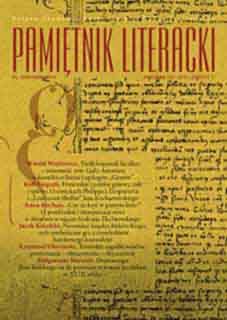Definicja jako źródło epigramatycznej argucji w jezuickiej teorii i praktyce
Definition as a Source of Epigrammatic Argutia in Jesuitic Theory and Practice
Author(s): Jarosław NowaszczukSubject(s): Literary Texts
Published by: Instytut Badań Literackich Polskiej Akademii Nauk
Keywords: argutia; Bauhusius; Cabilleau; baroque Jesuitic epigrams
Summary/Abstract: Making use of rhetoric in poetry making was obvious for old scholars and poets as rhetoric performed the function now taken over by literary studies. It is not surprising that it was referred to as in epigrammatic creativity when the point was to look for brilliant conclusions known as argutia. Such verbal trickery proved significant as it met the expectations of a baroque reader and fell within the scope which might be referred to as the then sense of literary aesthetics. Many Jesuitic scholars shared an unquestionable view that at the basis of proper argutias are places (loci) and definitions (ex definitione) placed among them. Defining in baroque elocution was thoroughly researched and clearly subcategorised. In the analyses no text based on a dialectic form of definition could be found. It cannot be, however, claimed that there were no attempts to employ such a form as well. Much more common were resorts to various, also multi-level, descriptive solutions. Some poets, as Bauhusius or Cabilleau, show a discernable inclination to use the definition as a textual material. The use of description did not exclude other measures, among which at least opposition, metaphorisation, dialogisation, alliteration, and acrostic are worthwhile. The language of the epigrams might be claimed reach; it is worthy of note that New Latin formulas and terms were often employed. Eventually, analysing baroque Jesuitic epigrams one cannot disregard the fact that strongly marked with rhetoric pieces are not uncommon, some of which undoubtedly refer to the norms governing definitions.
Journal: Pamiętnik Literacki. Czasopismo kwartalne poświęcone historii i krytyce literatury polskiej
- Issue Year: 2013
- Issue No: 3
- Page Range: 173-184
- Page Count: 12
- Language: Polish

